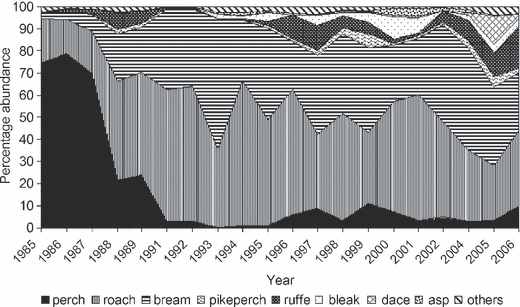 The inshore fish community of the Římov Reservoir in the Czech Republic was evaluated over 21 years using shore seining at night. The development of the fish community was divided into two separate phases: a highly dynamic and unstable phase dominated by perch, Perca fluviatilis L., was replaced by an extremely stable cyprinid phase dominated by roach, Rutilus rutilus (L.), and bream, Abramis brama (L.). The abundance of both these species oscillated during the cyprinid phase, but with decreasing amplitude. The proportion of piscivorous fish species such as asp, Aspius aspius (L.), pike, Esox lucius L., and pikeperch, Sander lucioperca (L.), increased slightly with time but remained low. The biomass of large Cladocera was negatively correlated with fish biomass only during the perch phase. The Shannon–Weaver index of diversity increased during the fish community succession, mainly because of greater evenness amongst the species.
The inshore fish community of the Římov Reservoir in the Czech Republic was evaluated over 21 years using shore seining at night. The development of the fish community was divided into two separate phases: a highly dynamic and unstable phase dominated by perch, Perca fluviatilis L., was replaced by an extremely stable cyprinid phase dominated by roach, Rutilus rutilus (L.), and bream, Abramis brama (L.). The abundance of both these species oscillated during the cyprinid phase, but with decreasing amplitude. The proportion of piscivorous fish species such as asp, Aspius aspius (L.), pike, Esox lucius L., and pikeperch, Sander lucioperca (L.), increased slightly with time but remained low. The biomass of large Cladocera was negatively correlated with fish biomass only during the perch phase. The Shannon–Weaver index of diversity increased during the fish community succession, mainly because of greater evenness amongst the species.
Keywords: biodiversity; cyprinids; perch; reservoir; stability; succession
